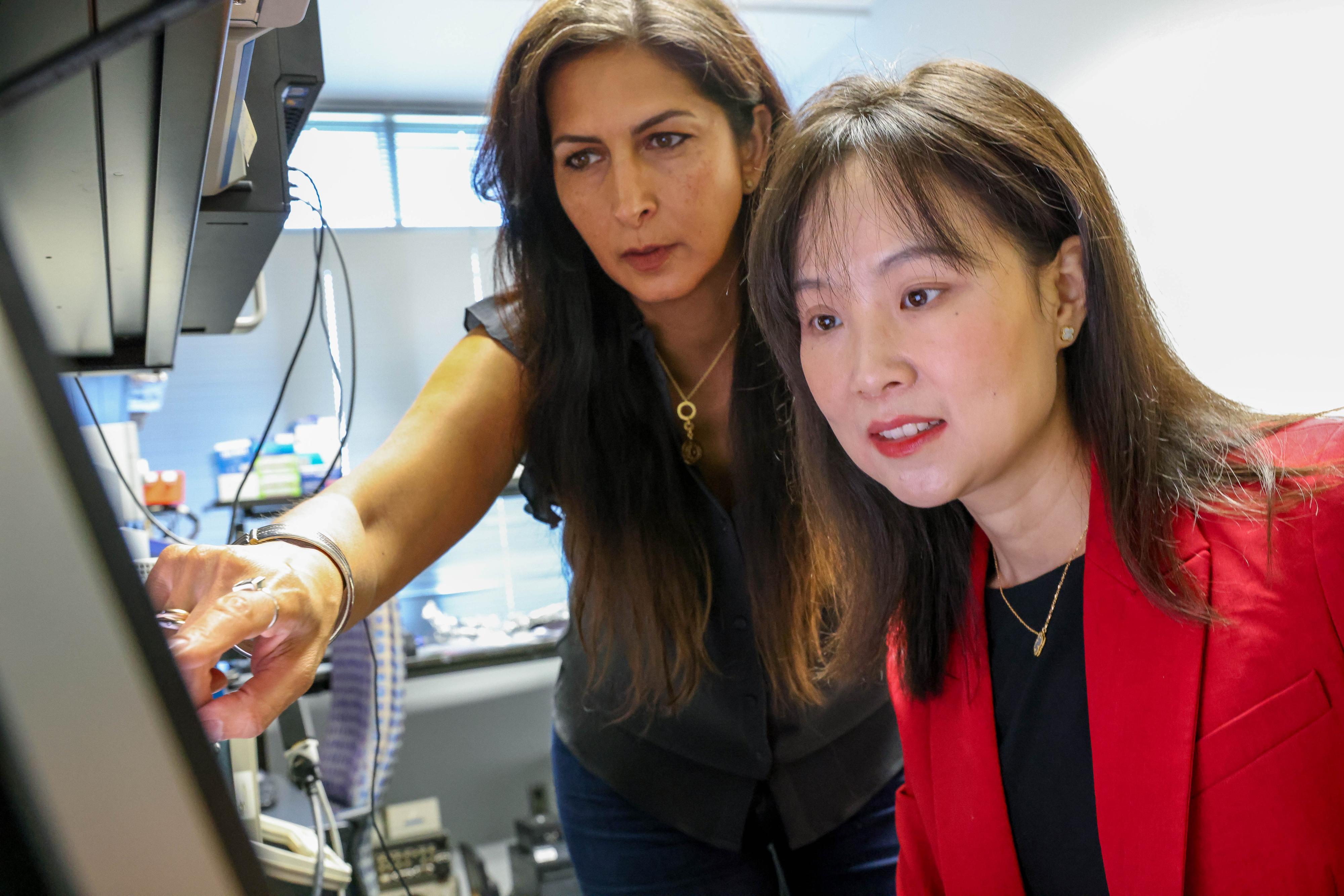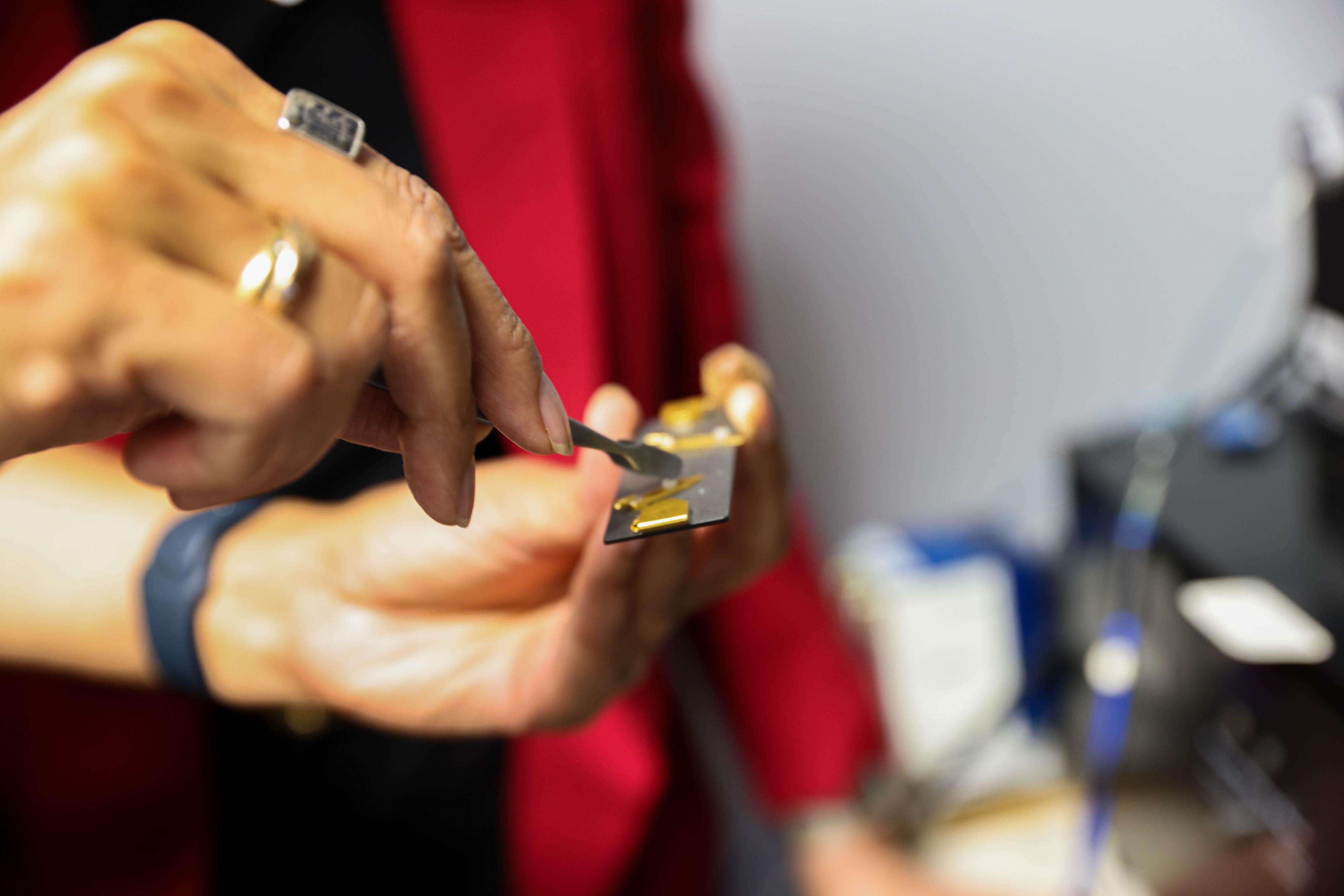
Pictured left to right: Nazanin Bassiri-Gharb, Harris Saunders, Jr. Chair and Professor in the Woodruff School and MSE, and Yao Xie, Coca-Cola Foundation Chair and Professor in ISyE. Photo by Mikey Fuller.
Finding Clarity in the Noise: A New Way to Recover Hidden Signals at the Nanoscale
Georgia Tech researchers develop a method to extract reliable information from noisy data in nanoscale imaging, advancing the study of ferroelectric materials.
August 7, 2025
By Ashley Ritchie
In the world of nanotechnology, seeing clearly isn’t easy. It’s even harder when you’re trying to understand how a material’s properties relate to its structure at the nanoscale. Tools like piezoresponse force microscopy (PFM) help scientists peer into the nanoscale functionality of materials, revealing how they respond to electric fields. But those signals are often buried in noise, especially in instances where the most interesting physics happens.
Now, researchers at Georgia Tech have developed a powerful new method to extract meaningful information from even the noisiest data, or when, alternatively, the response of the material is the smallest. Their approach, which combines physical modeling with advanced statistical reconstruction, could significantly improve the accuracy and confidence of nanoscale measurement properties.
The team’s findings, led by Nazanin Bassiri-Gharb, Harris Saunders, Jr. Chair and Professor in the George W. Woodruff School of Mechanical Engineering and School of Materials Science and Engineering (MSE), are reported in Small Methods.
Co-lead authors Kerisha Williams, a former MSE Ph.D. student, and Henry Shaowu Yuchi, a former Ph.D. student in the H. Milton Stewart School of Industrial and Systems Engineering (ISyE), spearheaded the study. Other collaborators include Kevin Ligonde, a Ph.D. student in the Woodruff School; Mathew Repasky, a former Ph.D. student in ISyE; and Yao Xie, Coca-Cola Foundation Chair and Professor in ISyE.
This research was initiated through Georgia Tech’s Forming Teams and Moving Teams Forward seed grant program, launched by the Office of the Executive Vice President for Research in 2021. Designed to support cross-disciplinary collaboration, the program helps build research teams that align with the growing national emphasis on large-scale, team-based projects. The grant supported early work by Bassiri-Gharb, Xie, and Juan-Pablo Correa-Baena, associate professor and Goizueta Early Career Faculty Chair in MSE.
The Signal Problem
PFM is a type of scanning probe microscopy technique. It’s a key tool for understanding how materials behave at the smallest scales. This technique works by scanning a tiny cantilever tip across a surface while applying an electric field, then measuring how the surface responds, revealing details about electromechanical and polar properties.
But there’s a catch: in regions where polarization switches, such as during the transition from positive to negative polar direction, the electromechanical response naturally drops to zero. This is expected physics. And when working at the nanoscale, there’s almost always a substantial amount of noise. That combination can cause the signal-to-noise ratio (SNR) to fall sharply, making the data misleading or unusable, especially if small errors are mistaken for exotic new phenomena.
“These low-SNR regions aren’t just noise, they’re often where the most critical information lives,” said Williams. “We needed a way to recover that data without introducing new artifacts.”
A Smarter Way to Fill in the Gaps
Traditionally, researchers have tried to “clean” low-SNR data points using simple interpolation or by discarding and replacing values one at a time. But those methods can disrupt the physical relationships between extracted information, leading to inaccurate or incomplete interpretations.
The Georgia Tech team took a different approach. First, they used errors from the standard signal-fitting process, based on a simple harmonic oscillator model of the tip surface contact, to detect which data points were unreliable. Then, instead of patching them one by one, they used statistical machine learning approaches to reconstruct entire segments of missing or noisy signals. This preserved the natural correlation between parameters like amplitude, phase, frequency, and damping.
The team used a new statistical machine learning method developed by the ISyE research group, called Bayesian matrix completion (BayeSMG). This method is designed to make sense of messy and incomplete data by finding patterns and reducing noise. It works well when there are similarities across different measurements, helping to reveal meaningful signals that might otherwise be hidden. In the context of PFM, this method helps researchers better understand how the material behaves.
“The new BayeSMG has been largely developed as a general statistical learning framework for low-rank matrices and is part of Henry’s Ph.D. thesis; we are excited about its first real-world application in such an impactful domain,” said Xie.
After cleaning up the data, the team applied a standard model to extract values that make sense physically and match known behavior. BayeSMG also provides information about how confident researchers can be in these results by estimating uncertainty.
“Our method doesn’t just guess what the signal should be; it builds it back using the underlying structure of the data,” said Bassiri-Gharb. “That gives us much more confidence in what we’re measuring.”
Rethinking Past Assumptions
When applied to a lead magnesium niobate-lead titanate (a material routinely used in underwater acoustic transducers and medical ultrasound devices), the method revealed a cleaner and more physically realistic dynamic polar behavior than conventional techniques. In particular, it eliminated misleading artifacts, like signal plateaus or sudden jumps and dips, that have sometimes been interpreted as signs of complex phase transitions or mechanical coupling.
By reconstructing the true nanoscale response in the low signal-to-noise regime, the method opens the door to a clearer understanding of materials that are critical for sensors, actuators, memory devices, and energy systems.
Even more importantly, the team emphasized transparency. They documented each step of the data-processing pipeline, calling attention to the subjective decisions researchers often make behind the scenes, like choosing frequency ranges, phase calibration methods, or error thresholds. These choices, while routine, can significantly affect outcomes.
A Blueprint for Better Science
“This work fills a major gap in the field,” said Williams. “There’s been no standard for handling noisy data in signal-modulated SPM. We’re not just offering a tool, we’re offering a process that others can follow, replicate, and improve on.”
Bassiri-Gharb and Williams hope their approach will serve as a model for the broader SPM community and beyond. They advocate for open sharing of metadata, code, and processing details, aligning with the F.A.I.R. principles that promote reproducible and transparent science.
And while their method was demonstrated in PFM, it applies to a wide range of techniques where external fields are used to probe materials at the nanoscale.
“In many ways, this is like finding a needle in a haystack,” Bassiri-Gharb said. “With the right tools and a little patience, we’re learning how to recover the signals that matter most.”
Acknowledgments
The authors gratefully acknowledge support from the U.S. National Science Foundation (NSF) through grant DMR-2026976; the Harris Saunders Jr. endowed Chair funds at Georgia Institute of Technology; the Alfred P. Sloan Foundation Minority Ph.D. program, grant G-2019-11435; and the NSF CAREER CCF-1650913.

